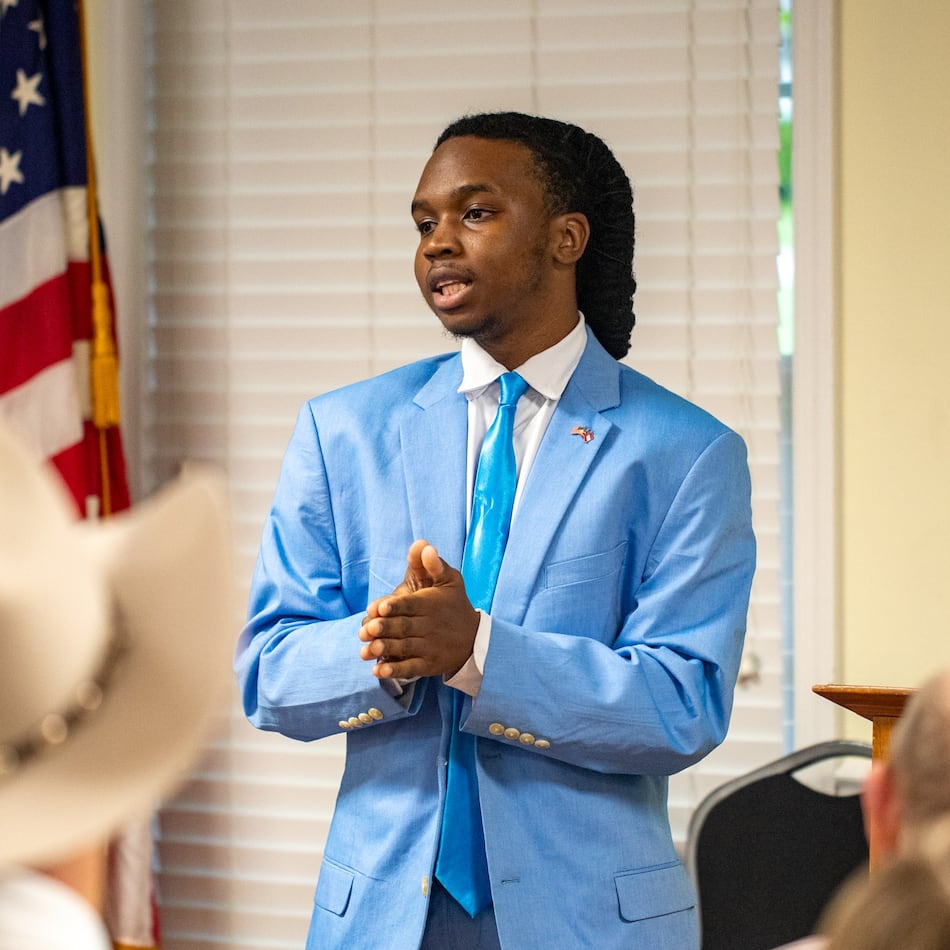HAZLEHURST — The mystery took wing on a thunderstorm.
Now, this was no mere black cloud of driving rain and lightning bolts. This was a stampede of wind, the likes of which cattle farmer Charles Marchant, in all his 81 years, had never seen.
The wintertime tempest of January 9 howled north across Hurricane Creek. It whistled over Kirkland Still Road, where tobacco once grew.
On its midday charge toward Marchant’s 115-acre spread in Jeff Davis County, the storm sheared metal rooftops, clipped pine tops and sucked wooden shingles off an 1890s farmhouse. Then it took aim on Marchant’s pastures, where 150-odd cows and calves in the Marchant herd graze under the watchful eyes of three black bulls.
Two of those bulls were penned in a grassy enclosure ringed by a taut, 5-foot-high, galvanized barbed wire fence. The bulls had been isolated to keep them from overbreeding. In a corral beside them, just across the barbed wire, were horses. No gates were open.
Short of an improbable — nigh impossible — leap, there was no escape; no way for the bulls to get inside the horse pen.
Enter the tempest.
Its 100-plus-mph winds blew away part of a metal barn near the horse pen, which sits next to the brick house where Marchant’s son, Zachary, lives. A 600-gallon water trough there was tossed over treetops, sent sailing some 200 yards.
In the water trough were, perhaps, 2 tons of water. One of the Marchant bulls, a particularly ornery specimen purchased a few years back at a University of Georgia livestock sale, weighs in substantially less than that, but is still hefty at roughly 1,500 pounds.
As the storm subsided, Zachary Marchant peeked outside.
“I know I don’t see as good as I used to,” he said to his wife, “but that looks like there’s a damn bull in there with them horses.”
Sure enough, there was.
Zachary Marchant inspected the fence. None of it was broken, sagging or tugged loose. The gates were shut. It made no sense.
Could the bull, with nary a scratch, have been blown over the fence?
Might a tornadic force, some atmospheric anomaly, have launched the beast just over the barbed wire and deposited it, unscathed, in the horse pen?
Wasn’t there a flying cow in that 1996 storm-chaser flick “Twister”? And if a fairy-tale cow jumped over the moon, might one, in an adrenaline-fueled moment of sheer terror, defy gravity enough to vault a 5-foot fence?
Days later, word of an airborne bovine was mentioned in a blurb from the National Weather Service.
In the wake of the storm, a weather service meteorologist from Jacksonville, Fla., had been sent north into Georgia. He had gone to examine destruction at the Marchant farm and in surrounding Jeff Davis County, just below where the Ocmulgee River meets the Oconee, 90 miles southeast of Macon.
The meteorologist met the Marchants, heard tell of the bull’s mysterious change of latitude, and, in a preliminary write-up, logged this account: that wind appeared to or may have “literally lifted a bull from one pasture to another.”
The media latched on to that account.
‘It’s just hilarious’
In the couple of weeks since then, the tale has taken flight.
The farmer, Charles Marchant, a Vietnam veteran and the son of a sharecropper, has taken his share of ribbing in his hometown of 4,088.
A flying bull? Seriously?
“I’ve had more people give me hell,” he said.
Credit: Joe Kovac Jr.
Credit: Joe Kovac Jr.
The other day, while a reporter for The Atlanta Journal-Constitution was visiting his farm, he said, “The first thing I want you to write down in your notes is, I’m 81 years old, and I’m too old to start lying now about flying damn bulls.”
He reckoned that maybe the bull jumped the fence. “But he didn’t break the wire nowhere,” he said. “He’d have to really hop.”
So how could it happen?
“I don’t know,” he said.
But, if wind can lift an 18-wheeler off a highway, it can surely pick up a 1,500-pound bull, he reasoned. Then he said, “I’m not saying that’s what happened, though.”
An appearance on the TV news in Savannah has afforded Marchant a small dose of celebrity. He has jokingly offered his autograph to a former state representative who watched the flying-bull segment and called to say hello.
“It’s just hilarious,” Wanda Marchant, his wife, said of the cattle caper.
She was the local tourism director years ago.
“If we’d have had this going on,” she said, “I could have really marketed Hazlehurst.”
‘When cows fly’
The area has a history of seemingly tall tales involving animals. In 1932, the world-record largemouth bass, a 22-pound, 4-ouncer, was caught in an oxbow lake about 10 miles west of the Marchant farm.
Until his death in 1996, a Belgian draft horse named Peppermint Pete may have been the most famous animal in Jeff Davis County. He was, according to published accounts, the town pet, “as gentle as any dog.” Pete’s owner, Steve Underwood, who learned by chance of his horse’s penchant for chomping candy, began buying peppermint by the 5-gallon jug.
On a recent afternoon around lunchtime, Underwood was dining at the Hazlehurst Dairy Queen. It so happens that Underwood, the proprietor of a horse auction just up the Golden Isles Parkway, lives a mile or two from the Marchant farm. He went there himself soon after the storm. And, yes, he heard about the flying bull.
“It’s weird, but it’s possible,” Underwood said. “That old big cow can’t jump that high. He may run through (the fence), but he ain’t gonna go over it.”
Credit: Joe Kovac Jr.
Credit: Joe Kovac Jr.
At another booth on the other side of the Dairy Queen, a man named Todd Moseley was having lunch with his son, Will.
Moseley was working near the Marchant farm the day of the storm and drove by to check on downed power lines.
“The cow wasn’t hurt. The cow was just standing there,” said Moseley, who is familiar with the bull’s ornery reputation. “I don’t know if he got picked up (by the wind) and put in there or if he tore in there. But he had a different attitude after that storm.”
Will Moseley, his son from nearby Snipesville, plays guitar and sings country music. He is a contestant on the upcoming season of “American Idol.” Last week, the show sent a camera crew to Hazlehurst to chronicle his roots.
It was unclear whether the producers caught wind of the bull.
But a chance remains they might.
Speaking of his musician son, Todd Moseley said, “He needs to write a song about the cow. When cows fly and ‘American Idol’ comes to town, we know it’s special.”
‘Definitely seems credible’
The weather service has since clarified its findings on the bull.
Jacksonville-based meteorologist Al Sandrik, in an email, explained how he had gone to Hazlehurst and spoken to the Marchants — “very nice, friendly people” — for more than half an hour.
“And I never do that during a storm survey,” he wrote.
Sandrik went on to say that the account of the bull being blown over the fence “definitely seems credible.”
The tricky part, he noted, is that most of the damage there was caused by what are known as straight-line winds. However, there is “some evidence of twisting,” which is what it might have taken to blow the bull into the pen where he ended up.
Such damage is perhaps attributable to a vortex or whirlwind that can form in thunderstorm downbursts. They’re not tornadoes, but are akin to dust devils, with a name that sounds like the title of a horrendous B-movie: gustnadoes.
“Now whether a gustnado is capable of the account,” Sandrik explained, “we’re just not sure.”
In sum: “The analysis on the bull is ‘unproved.’ … That is not saying it’s a fabrication, we just can’t scientifically prove it one way or the other.”
Even so, brilliant minds somewhere may still be running the numbers.
Juergen Rauleder, a professor of vertical lift aerodynamics at Georgia Tech, is an expert on the forces required to, as he put it, “lift something up.”
As for what it might take to send the 1,500-pound bull aloft, he said, if wind alone needs to do that, “what you basically need is a pressure difference above and below the bull that is equal to that weight.”
He wasn’t sure that a windstorm like the one on the Marchant farm could pack such power.
“It’s not an airfoil. It’s not a wing. It’s not a barn door either. It’s a bull,” Rauleder said. “So I think that even with a very strong wind speed in the order of 100, 110 miles per hour ... it doesn’t generate this kind of lift.”
But the story of the flying bull does not end there.
No, the far-fetched fable seems to have blown farther and wider.
About a week ago, someone mentioned to Rauleder that a student was interested in tackling an unusual homework assignment.
The subject, you guessed it, the aerodynamic lift generated by a bull.
“Sometimes,” the professor said of the remarkable coincidence, “I don’t know how the universe functions.”
About the Author
Keep Reading
The Latest
Featured




